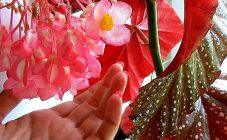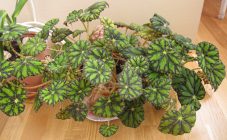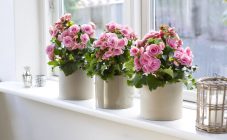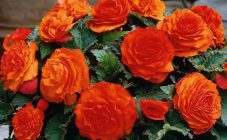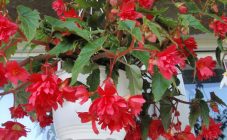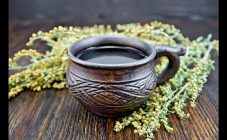Content:
Begonia (lat. Begonia) is one of the most popular decorative flowering deciduous plants of the Begonia family. Today there are thousands of hybrid forms and varieties of begonias. The most famous among them are the species bred in Belgium. Everything about the begonia flower will be detailed in this article.
What is this plant
For the first time, a description of begonia was compiled by the French botanist and monk Charles Plumier, who in 1687 discovered the plant in the Antilles during a scientific expedition. In 1690, the scientist named the new genus "begonia" - in honor of his friend M. Begon, the governor of Haiti. Today, these plants are found in the mountains of India, in the Malay Archipelago, in the Himalayas, in Sri Lanka and in western Africa.
Since its introduction into Europe, begonia has enjoyed immense popularity in horticulture. It is cultivated both indoors and in the garden, however, the leaves of the indoor subspecies contain a much larger proportion of phytoncides - substances that have a cleansing effect on the body, but the beneficial properties of begonia are not limited to this.
The air in the room where the flower is located becomes cleaner, which affects a number of processes:
- improves performance;
- strengthens the immune system;
- helps to treat chronic fatigue;
- improves mood.
Plant characteristic
It is difficult to give an exhaustive answer to the question of what begonia looks like, since many varieties and hybrid forms are distinguished. There are herbaceous species, no more than 5 cm in height, shrubs with nondescript flowers, climbing shrubs, vines and even epiphytes that grow from the bark of trees. Finally, there are subspecies grown in pots and varieties intended for planting in open ground.
The leaves of the plant are in most cases asymmetrical, one side is always larger than the other. The size and color of the leaves, as well as the density of the foliage, vary from cultivar to cultivar.
Flowers in decorative deciduous species are small and inconspicuous, while flowering varieties, on the contrary, are distinguished by large bright flowers of various colors. The shape of the flowers also depends on the variety: there are types with regular and double petals, monochromatic and gradient. A group of rose-like varieties is especially distinguished.
In all species, the flowers are monoecious, unisexual, the fruits resemble a box in appearance. Annual begonia, as a rule, has smaller tubers than perennial ones.
Characteristics of species and varieties of crops
It is customary to distinguish two large groups of culture that is grown in indoor conditions - decorative leafy begonias and flowering begonias. A distinctive feature of the former is the variety of shapes and colors of leaves. Flowering varieties are distinguished by the richness of flower shapes.
The most popular types of begonias include:
- Tuberous - begonia with double and smooth petals, the color of which ranges from white and pale pink to bright red and orange shades. This species is distinguished by the presence of a perennial tuber. The flowers are large - from 8 to 14 cm in diameter, the shape resembles the buds of a peony or rose.
- Eternal Blossoming is a garden culture that blooms all year round in indoor conditions. Differs in glossy reddish-green leaves. The color of the flowers is white, pink, red.
- Ampelnaya - characterized by soft hanging branches up to 50 cm long. Flowers are small, the color varies from delicate yellowish shades to bright crimson tones.
- Elatior is a hybrid of begonia that looks like a rose. This is an exceptionally homemade tuberous variety with thin reddish shoots for which props need to be prepared. Flower petals of white, yellow, red, orange tones. Glossy round leaves.
- Royal begonia (or Rex) is distinguished by the complete absence of flowers, which makes up for the unusual color of the leaves. Rounded, heart-shaped leaf plates are partly colored red.
Features of planting and care
Despite the unusual appearance and exotic origin, begonia is one of the most unpretentious garden and indoor plants: it is undemanding to the type of soil and frequent watering, and even a beginner grower can comply with the conditions for keeping a flower.
Illumination requirements
Begonias grow and develop better in partial shade, but flowering species need sun. This does not mean that the plant should be exposed to direct sunlight - in order to avoid sunburn, it is recommended to provide the flowers with diffused lighting.
Air humidity level
Under natural conditions, begonia grows in a humid climate and needs high humidity, but the flower cannot be sprayed.
Temperature regime
The most favorable temperature in summer is from +14 ° C to 22 ° C, in winter - about +14 ° C.
The tubers can be stored at + 10 ° C for about two months.
Watering
Begonia is watered only when the topsoil is completely dry. To do this, use warm, settled water. In winter, watering is minimized.
Top dressing
Feeding begonias with minerals and vitamins should be carried out regularly, once every two weeks from March to October. The rest of the year, the plant is dormant, and this applies even to ever-flowering varieties.
Formation of culture
When pruning a begonia flower, remove the leaves from the top of the stem. The peduncle itself is cut off with a hemp of about 5 cm, which is transferred to the shade. It must be sprayed several times a day. As a result, young shoots will soon begin to form. To form a beautiful shape, the lateral shoots are pinched.
Reproduction
Begonia is propagated by cuttings and sheet method.
The grafting procedure is as follows:
- Cut a flower stalk 8-10 cm long with 2-4 pairs of leaves.
- Dry the slice.
- Cut cuttings are dipped into a pot in a soil mixture consisting of sand and soil.
- Cover the stalk with a cut plastic bottle.
- A month later, with the appearance of the first leaves, the bottle is removed.
Leaf propagation is carried out as follows:
- The begonia leaf is cut in the direction from the central vein to the edges of the plate so that several pieces in the form of a triangle are obtained. Moreover, each triangle must contain at least one vein.
- The pieces are placed on a layer of wet sand and covered with cellophane film.
- The air under the film is periodically sprayed from a spray bottle.
- After 3 months, the plant can be planted in the soil.
Major diseases and pests of culture
Most often begonia is sick with powdery mildew and gray mold. Powdery spots and plaque on the leaves are signs of these diseases.
The development of the disease is provoked by the increased humidity of the soil and air, as well as the shade of the plant. The fight against powdery mildew and gray mold involves treatment with fungicides.
Begonia in landscape design
Begonia flowers are used as decorative deciduous and flowering plants for landscaping living quarters in group or single flower arrangements, as well as in ampelous indoor culture, winter gardens in hanging baskets, pots. The bindweed begonia can be used to decorate trellises, walls, windows and as a ground cover plant. In addition, begonias are used for romantic interiors. The plant is also planted in a flower bed, especially the ever-flowering begonia, which blooms before frost.
What is begonia? This is an exotic, but unpretentious flower, which is easy to care for. Moreover, it boasts not only the original shape of the leaves and the variety of inflorescences - the healing effect of this plant has been scientifically proven. It will not only fill the house with scent during flowering, but also purify the air.







